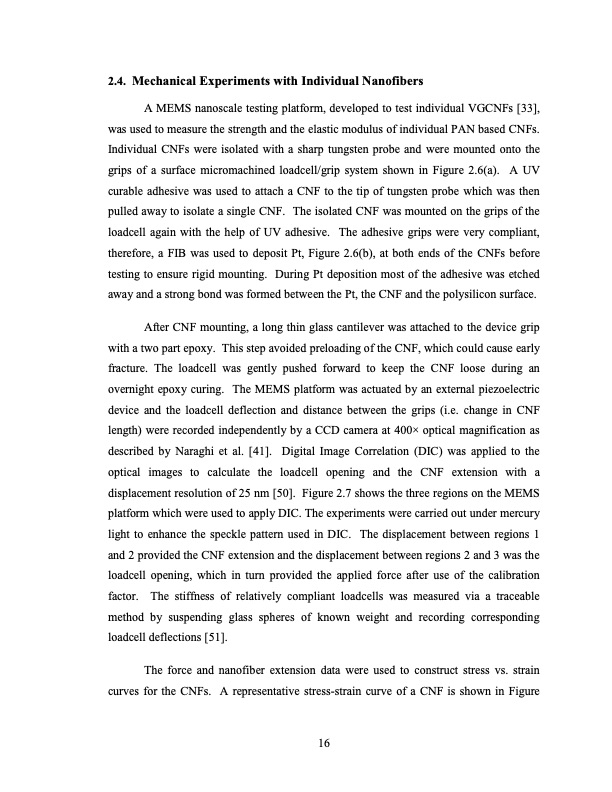
PDF Publication Title:
Text from PDF Page: 023
2.4. Mechanical Experiments with Individual Nanofibers A MEMS nanoscale testing platform, developed to test individual VGCNFs [33], was used to measure the strength and the elastic modulus of individual PAN based CNFs. Individual CNFs were isolated with a sharp tungsten probe and were mounted onto the grips of a surface micromachined loadcell/grip system shown in Figure 2.6(a). A UV curable adhesive was used to attach a CNF to the tip of tungsten probe which was then pulled away to isolate a single CNF. The isolated CNF was mounted on the grips of the loadcell again with the help of UV adhesive. The adhesive grips were very compliant, therefore, a FIB was used to deposit Pt, Figure 2.6(b), at both ends of the CNFs before testing to ensure rigid mounting. During Pt deposition most of the adhesive was etched away and a strong bond was formed between the Pt, the CNF and the polysilicon surface. After CNF mounting, a long thin glass cantilever was attached to the device grip with a two part epoxy. This step avoided preloading of the CNF, which could cause early fracture. The loadcell was gently pushed forward to keep the CNF loose during an overnight epoxy curing. The MEMS platform was actuated by an external piezoelectric device and the loadcell deflection and distance between the grips (i.e. change in CNF length) were recorded independently by a CCD camera at 400× optical magnification as described by Naraghi et al. [41]. Digital Image Correlation (DIC) was applied to the optical images to calculate the loadcell opening and the CNF extension with a displacement resolution of 25 nm [50]. Figure 2.7 shows the three regions on the MEMS platform which were used to apply DIC. The experiments were carried out under mercury light to enhance the speckle pattern used in DIC. The displacement between regions 1 and 2 provided the CNF extension and the displacement between regions 2 and 3 was the loadcell opening, which in turn provided the applied force after use of the calibration factor. The stiffness of relatively compliant loadcells was measured via a traceable method by suspending glass spheres of known weight and recording corresponding loadcell deflections [51]. The force and nanofiber extension data were used to construct stress vs. strain curves for the CNFs. A representative stress-strain curve of a CNF is shown in Figure 16PDF Image | HIGH STRENGTH CARBON NANOFIBERS DERIVED FROM ELECTROSPUN POLYACRYLONITRILE

PDF Search Title:
HIGH STRENGTH CARBON NANOFIBERS DERIVED FROM ELECTROSPUN POLYACRYLONITRILEOriginal File Name Searched:
4835609.pdfDIY PDF Search: Google It | Yahoo | Bing
Sulfur Deposition on Carbon Nanofibers using Supercritical CO2 Sulfur Deposition on Carbon Nanofibers using Supercritical CO2. Gamma sulfur also known as mother of pearl sulfur and nacreous sulfur... More Info
CO2 Organic Rankine Cycle Experimenter Platform The supercritical CO2 phase change system is both a heat pump and organic rankine cycle which can be used for those purposes and as a supercritical extractor for advanced subcritical and supercritical extraction technology. Uses include producing nanoparticles, precious metal CO2 extraction, lithium battery recycling, and other applications... More Info
| CONTACT TEL: 608-238-6001 Email: greg@infinityturbine.com | RSS | AMP |